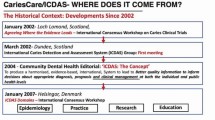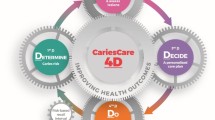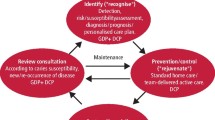Abstract
The latest estimates from the Global Burden of Disease study show that dental caries remains a neglected global health issue, with over two billion people suffering the consequences of this highly preventable disease globally. The two main goals of a national health system are to improve population health and reduce health inequalities, which are often achieved through prevention and promotion for everyone, as well as treatment and rehabilitation for the sick. Oral health promotion should be integrated with national policies for the prevention of non-communicable diseases, especially those targeting the intake of free sugars. The ongoing debate on universal health coverage (UHC) offers a unique opportunity to align dental care with essential health services, which all countries are expected to provide. Minimal intervention dentistry (MID) protocols for management of carious lesions, such as the atraumatic restorative technique, silver diamine fluoride and the Hall Technique, could help tackle the global burden of untreated caries as they are cost-effective in the long run. However, the successful implementation in primary dental care and training the new cadre of dentists adequately are pending issues if MID is to facilitate the inclusion of dental care as part of the UHC agenda.
Key points
-
Summarises the latest set of estimates on the burden of untreated caries around the globe.
-
Discusses policy options to reduce the burden of untreated caries.
-
Discusses the relevance of minimal intervention dentistry to tackle this burden from the perspective of national healthcare systems and the universal health coverage agenda.
This is a preview of subscription content, access via your institution
Access options
Subscribe to this journal
Receive 24 print issues and online access
$259.00 per year
only $10.79 per issue
Buy this article
- Purchase on Springer Link
- Instant access to full article PDF
Prices may be subject to local taxes which are calculated during checkout


Similar content being viewed by others
References
GBD 2017 Oral Disorders Collaborators, Bernabe E, Marcenes W et al. Global, Regional, and National Levels and Trends in Burden of Oral Conditions from 1990 to 2017: A Systematic Analysis for the Global Burden of Disease 2017 Study. J Dent Res 2020; 99: 362-373.
GBD 2017 DALYs and HALE Collaborators. Global, regional, and national disability-adjusted life-years (DALYs) for 359 diseases and injuries and healthy life expectancy (HALE) for 195 countries and territories, 1990-2017: a systematic analysis for the Global Burden of Disease Study 2017. Lancet 2018; 392: 1859-1922.
GBD 2017 Disease and Injury Incidence and Prevalence Collaborators. Global, regional, and national incidence, prevalence, and years lived with disability for 354 diseases and injuries for 195 countries and territories, 1990-2017: a systematic analysis for the Global Burden of Disease Study 2017. Lancet 2018; 392: 1789-1858.
Marcenes W, Kassebaum N J, Bernabe E et al. Global burden of oral conditions in 1990-2010: a systematic analysis. J Dent Res 2013; 92: 592-597.
Kassebaum N J, Bernabe E, Dahiya M et al. Global burden of untreated caries: a systematic review and metaregression. J Dent Res 2015; 94: 650-658.
Kassebaum N J, Smith A G C, Bernabé E et al. Global, Regional, and National Prevalence, Incidence, and Disability-Adjusted Life Years for Oral Conditions for 195 Countries, 1990-2015: A Systematic Analysis for the Global Burden of Diseases, Injuries, and Risk Factors. J Dent Res 2017; 96: 380-387.
Pitts N B, Baez R J, Diaz-Guillory C et al. Early Childhood Caries: IAPD Bangkok Declaration. J Dent Child (Chic) 2019; 86: 72.
Tinanoff N, Baez R J, Diaz Guillory C et al. Early childhood caries epidemiology, aetiology, risk assessment, societal burden, management, education, and policy: Global perspective. Int J Paediatr Dent 2019; 29: 238-248.
GBD 2017 Mortality Collaborators. Global, regional, and national agesexspecific mortality and life expectancy, 1950-2017: a systematic analysis for the Global Burden of Disease Study 2017. Lancet 2018; 392: 1684-1735.
World Health Organisation. The World Health Report - Health systems financing: the path to universal coverage. 2010. Available at https://apps.who.int/iris/bitstream/handle/10665/44371/9789241564021_eng.pdf (accessed September 2020)..
Moynihan P J, Kelly S A. Effect on caries of restricting sugars intake: systematic review to inform WHO guidelines. J Dent Res 2014; 93: 8-18.
Bernabé E, Vehkalahti M M, Sheiham A, Lundqvist A, Suominen A L. The Shape of the Dose-Response Relationship between Sugars and Caries in Adults. J Dent Res 2016; 95: 167-172.
Watt R G, Daly B, Allison P et al. Ending the neglect of global oral health: time for radical action. Lancet 2019; 394: 261-272.
Sheiham A, Watt R G. The common risk factor approach: a rational basis for promoting oral health. Community Dent Oral Epidemiol 2000; 28: 399-406.
Karki S, Pakkila J, Laitala M L, Humagain M, Anttonen V. Influence of dental caries on oral health-related quality of life, school absenteeism and school performance among Nepalese schoolchildren. Community Dent Oral Epidemiol 2019; 47: 461-469.
Krisdapong S, Prasertsom P, Rattanarangsima K, Sheiham A. School absence due to toothache associated with sociodemographic factors, dental caries status, and oral health-related quality of life in 12and 15yearold Thai children. J Public Health Dent 2013; 73: 321-328.
Hayes A, Azarpazhooh A, Dempster L, Ravaghi V, Quinonez C. Time loss due to dental problems and treatment in the Canadian population: analysis of a nationwide cross-sectional survey. BMC Oral Health 2013; 13: 17.
Righolt A J, Jevdjevic M, Marcenes W, Listl S. Global-, Regional-, and Country-Level Economic Impacts of Dental Diseases in 2015. J Dent Res 2018; 97: 501-507.
Masood M, Sheiham A, Bernabe E. Household expenditure for dental care in low and middle income countries. PLoS One 2015; DOI: 10.1371/journal.pone.0123075.
Bernabe E, Masood M, Vujicic M. The impact of outofpocket payments for dental care on household finances in low and middle income countries. BMC Public Health 2017; 17: 109.
Yee R, Sheiham A. The burden of restorative dental treatment for children in Third World countries. Int Dent J 2002; 52: 1-9.
Banerjee A, Frencken J E, Schwendicke F, Innes N P T. Contemporary operative caries management: consensus recommendations on minimally invasive caries removal. Br Dent J 2017; 223: 215-222.
Innes N P T, Chu C H, Fontana M et al. A Century of Change towards Prevention and Minimal Intervention in Cariology. J Dent Res 2019; 98: 611-617.
Schwendicke F. Less Is More? The Long-Term Health and Cost Consequences Resulting from Minimal Invasive Caries Management. Dent Clin North Am 2019; 63: 737-749.
Frencken J E, Peters M C, Manton D J et al. Minimal intervention dentistry for managing dental caries - a review: report of a FDI task group. Int Dent J 2012; 62: 223-243.
Frencken J E. Atraumatic restorative treatment and minimal intervention dentistry. Br Dent J 2017; 223: 183-189.
Urquhart O, Tampi M P, Pilcher L et al. Nonrestorative Treatments for Caries: Systematic Review and Network Meta-analysis. J Dent Res 2019; 98: 14-26.
Innes N P, Evans D J, Stirrups D R. Sealing caries in primary molars: randomized control trial, 5year results. J Dent Res 2011; 90: 1405-1410.
Schwendicke F, Stolpe M, Innes N. Conventional treatment, Hall Technique or immediate pulpotomy for carious primary molars: a cost-effectiveness analysis. Int Endod J 2016; 49: 817-826.
Tonmukayakul U, Arrow P. Cost-effectiveness analysis of the atraumatic restorative treatment-based approach to managing early childhood caries. Community Dent Oral Epidemiol 2017; 45: 92-100.
Schwendicke F, Krois J, Splieth C H et al. Cost-effectiveness of managing cavitated primary molar caries lesions: A randomized trial in Germany. J Dent 2018; 78: 40-45.
Schwendicke F, Krois J, Robertson M et al. Cost-effectiveness of the Hall Technique in a Randomized Trial. J Dent Res 2019; 98: 61-67.
World Health Organisation and The World Bank. Tracking universal health coverage: 2017 global monitoring report. 2017. Available at https://apps.who.int/iris/bitstream/handle/10665/259817/9789241513555-eng.pdf (accessed September 2020).
Peters D H, Adam T, Alonge O, Agyepong I A, Tran N. Implementation research: what it is and how to do it. BMJ 2013; DOI: 10.1136/bmj.f6753.
Proctor E, Silmere H, Raghavan R et al. Outcomes for implementation research: conceptual distinctions, measurement challenges, and research agenda. Adm Policy Ment Health 2011; 38: 65-76.
Brownson R C, Colditz G A, Proctor E K. Dissemination and implementation research in health: Translating science to practice. Oxford: Oxford University Press; 2012.
Author information
Authors and Affiliations
Corresponding author
Ethics declarations
The authors declare no conflict of interest in relation to this work.
Rights and permissions
About this article
Cite this article
Bernabé, E., Marcenes, W. Can minimal intervention dentistry help in tackling the global burden of untreated dental caries?. Br Dent J 229, 487–491 (2020). https://doi.org/10.1038/s41415-020-2155-9
Received:
Accepted:
Published:
Issue Date:
DOI: https://doi.org/10.1038/s41415-020-2155-9
This article is cited by
-
Irreversible pulpitis in mature permanent teeth: a cost-effectiveness analysis of pulpotomy versus root canal treatment
BMC Oral Health (2024)
-
Decoding early childhood caries: an in-depth analysis of YouTube videos for effective parental education
European Archives of Paediatric Dentistry (2023)
-
Management of white spot lesions induced during orthodontic treatment with multibracket appliance: a national-based survey
Clinical Oral Investigations (2022)
-
Hydroxypropylmethylcellulose as a film and hydrogel carrier for ACP nanoprecursors to deliver biomimetic mineralization
Journal of Nanobiotechnology (2021)



